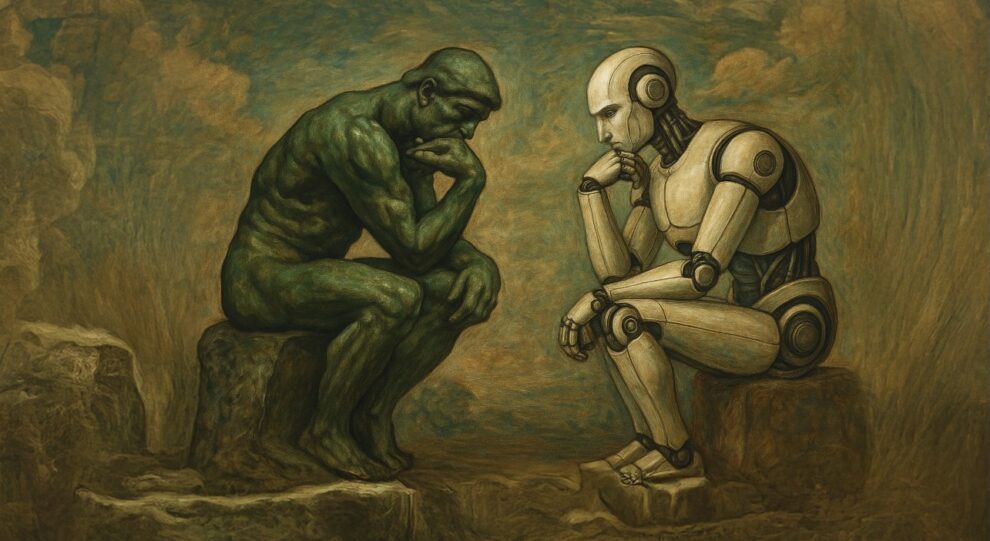There are two types of business leaders in 2025 – those who worry about how to use AI and liars. Across every industry, from finance to manufacturing and retail to consulting, AI is not just a trend, it’s a tsunami. And it’s providing us with the tools to amplify productivity AND creativity.
Waves of Change
AI is everywhere. It’s in our spreadsheets, our customer service chats and even our supply chains.
We are well past the novelty phase. As Seth Godin, American author, marketing expert, entrepreneur and a former dot-com business executive, said recently on The Tim Ferriss Show podcast (the No. 1 podcast on Apple), “AI is the biggest thing since electricity.”
And AI is powering everything from funny Sasquatch videos to investment portfolio analysis. The revolution isn’t coming, it’s already here.
But here’s the existential question: as AI gets better at doing what we do, what’s left for us?
The answer is EVERYTHING THAT MATTERS.
Pressure Cooker
Running a business has always been about juggling, whether it’s clients, competitors or the occasional crisis. Leaders face all kinds of pressures and right now it’s the urgent need to find productivity gains. Today, we’re juggling chainsaws.
Do I rationalize, upskill or hire staff?
Here’s an audacious thought: the companies that survive—and thrive—won’t be the ones running from AI. They’ll be the ones running toward it, investing in technology, training staff and using AI to amplify what makes us human.
The Robot’s Resumé
AI is really good at many things—analyzing numbers, augmenting workflows and automating repetitive tasks. It can crunch data at a pace that would make an actuary blush. It can manage inventory, help predict demand and even craft a decent e-mail. And in a life-improving way, it can automate the kind of mind-numbing, soul-sucking tasks, such as coming up with five variations of advertising copy within an Instagram post that has a 125-character limit, that cause us humans to procrastinate like crazy.
All the Feels (and Brent Spiner)
But here’s what AI can’t do: it can’t read the room or sense the subtle tension in a meeting. It can’t inspire a team or forge the kind of trust that comes from years of shared wins and losses. It doesn’t start conversations, have ideas of its own and it certainly can’t make you laugh so hard you snort hot coffee up your nose.
The real value of humans is our humanity: love, curiosity, empathy, strategic thinking and the ability to navigate the unpredictable. For those of us who are old enough to remember Star Trek: The Next Generation, Commander Data (a humanoid robot played by Brent Spiner) struggled to understand irony and humour. Today’s AI is no different.
Here today, gone tomorrow?
Many pundits believe if you’re not adapting, you’re screwed. They compare this moment in time to Kodak’s infamous failure to adapt to digital photography. (The one-time industry behemoth emerged from bankruptcy in 2013.) Forrester, a global research and advisory firm, predicts that millions of jobs will be lost to AI automation in the next decade.
This prediction can be seen as terrifying.
But here’s the daring counterpoint: business has always been in the business of reinvention. We’ve survived the rise of the internet, the virtual death of print (with this fine magazine being one of the few exceptions) and the explosion of social media. AI is both the latest challenge and the latest opportunity.
There will be new jobs that have yet to be conceived. Think back to the invention of combine harvesters. Would we ever go back to swathing wheat with a scythe? (Ask a farmer.)
Part Technologist, Part Philosopher, Part Storyteller
Tomorrow’s employees won’t just be number crunchers or creative geniuses. They’ll be part technologist, part philosopher and part storyteller. They’ll need to be more agile, think more critically, be more creative, and ironically, more human than ever.
They will be generalists who know the questions to ask and how to challenge the output, people who are able to discern between shit and shoe polish.
Companies that master AI integration will be able to offer enhanced services at scale, automating routine tasks and freeing up their teams to focus on high-impact strategies and innovations that AI can’t replace.
And they’ll do it all while embracing the messy, unpredictable and deeply human process of collaboration.
The Existential Question:
What’s Left for Us?
So, what’s left for business in the age of AI? Everything that matters. The ability to think critically, to challenge output and assumptions, to build trust and to create work that resonates on a human level.
The ability to adapt, to innovate and to find opportunities in chaos.
AI is a tool, not a replacement.
It’s a catalyst for change. The companies that flourish will be the ones that use AI to amplify their humanity—not the ones that try to out-robot the robots.
The Bottom Line: Don’t Panic.
Get Audacious.
If you’re running a business right now, you have two choices: you can resist change or you can get audacious. You can hide from AI (good luck with that) or you can lean in—hard.
Let the machines take over the boring stuff so you can focus on creating more magic.
The magic isn’t in the machines, it’s in the people. It’s in the shared experiences, the inside jokes and the unspoken trust that comes from seeing how your team handles pressure, success and the occasional disaster.
That’s something no algorithm can replicate. And that’s why, no matter how smart the robots get, the future of business will always be human.
Marty Fisher is the President / Principal of The Show and Tell Agency.


The Show and Tell Agency
Downtown Winnipeg – 130 Scott St.
645 Westmount Rd E. – Unit 17
1-431-668-4918 | theshowandtellagency.com
Email: marty@theshowandtellagency.com
LinkedIn










